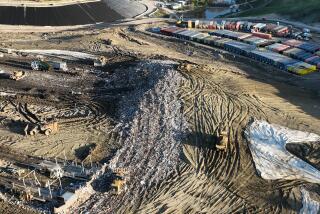Toxic Colorado mine blowout could have been prevented

Water flows through retention ponds built to contain and filter out heavy metals and chemicals from the Gold King mine accident.
The blowout at an abandoned Colorado gold mine in August that sent 3 million gallons of toxic mine waste into rivers below could have been prevented by the government agency that caused it -- the Environmental Protection Agency, according to a review released Thursday by another federal agency.
The report concluded that the EPA, which had been doing remediation work on the Gold King mine in southwestern San Juan County in consultation with the Colorado Division of Reclamation, Mining and Safety, breached a sealed mine pool after incorrectly estimating the level of water inside it.
The review said the agency chose not to directly measure the level of water by drilling into it, as it had on a previous project.
“Although this was apparently considered at Gold King, it was not done,” said the report, which was requested by the EPA and conducted by the Bureau of Reclamation. “Had it been done, the plan to open the mine would have been revised, and the blowout would not have occurred.”
EPA officials said in a statement that cleanup workers from the agency chose not to drill directly to assess the level of the mine pool because of a variety of factors, including the steepness of the site, cost, timing, technical challenges and safety factors.
The Aug. 5 disaster caused toxic water to transform parts of the Animas River into a poisonous orange stream, imagery that highlighted the toxic legacy of mining in the West. In its report, the bureau noted that legacy and said “the conditions and actions that led to the Gold King mine incident are not isolated or unique, and in fact are surprisingly prevalent.”
The Animas River has over the 125-year history of mining in the region taken on an estimated 8.6 million tons of mine tailings, the report noted.
It faulted what it called inconsistent methods for mine remediation “from one agency to another.”
“There are various guidelines for this type of work but there is little in actual written requirements that government agencies are required to follow when reopening an abandoned mine,” said the report, which was reviewed by the United States Geological Survey and the Army Corps of Engineers.
Reviewers found that the mine had not been properly sealed several years earlier and eventually “may have failed on its own” even if the EPA had not caused the spill in August. But they did not go as far as an EPA internal review, released in August, that determined the blowout “was likely inevitable.”
A peer reviewer from the Corps of Engineers, cited in the report, concluded that multiple bureaucratic breakdowns were likely contributing factors, and that “the actual cause of failure is some combination of issues related to EPA internal communications, administrative authorities, and/or a break in the decision path.”
The EPA said it would “carefully review” the report, adding that it would “help inform EPA’s ongoing efforts to work safely and effectively at mine sites as we carry out our mission to protect human health and the environment.”
More to Read
Sign up for Essential California
The most important California stories and recommendations in your inbox every morning.
You may occasionally receive promotional content from the Los Angeles Times.











